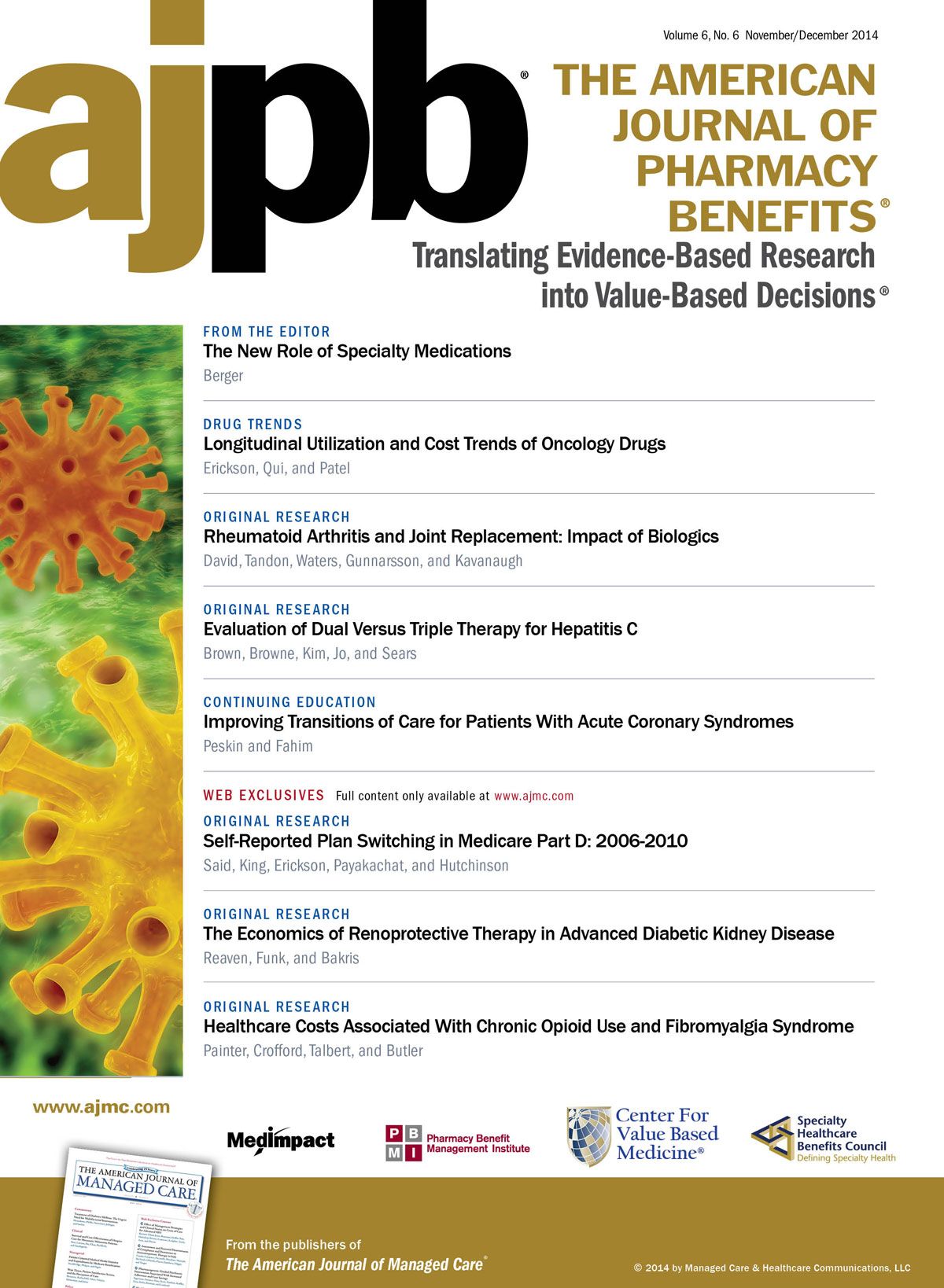Publication
Article
AJPB® Translating Evidence-Based Research Into Value-Based Decisions®
Longitudinal Trends of Utilization, Cost, and Prevalence in Oncology
Author(s):
Annual rates of increase in oncology drug utilization, drug price, and plan spending are quantified and potential contributors are explored.
It is estimated that in the United States there will be 1.7 million new cases of cancer in 2014. Cancer remains the second-leading cause of death in the United States, just behind heart disease.1,2 Although in recent years the death rate for all cancers combined has decreased and the overall incidence of cancer has stabilized in the United States,3 because cancer incidence is highest in the elderly, the aging of the population and prolonged survival will likely increase the percentage of Americans being treated for cancer. The US Census Bureau projects that the population 65 years and older will grow from 48 million in 2015, to 65 million in 2025.4 A 27% increase in national cancer care costs between 2010 and 2020 has been predicted because of the aging and growing of the US population alone.5
Oncology drug spend is increasing within the pharmacy benefit as more self-administered oral oncology drugs enter the market.6 According to 2013 pharmacy benefit manager (PBM) reports, cancer was the third-most costly condition to treat within the specialty drug categories.7 The average cost per month of a branded oncology drug in the United States increased from $5000 to $10,000 within the past 10 years.8 Newer drugs tend to be priced higher than previous therapies despite the lack of correlation between the price and overall survival or quality-adjusted life-years.9,10 Many existing oncology drugs have had dramatic increases in price that far exceed the rate of inflation.10,11 Oncology has the greatest number of drugs in development, with 4 times as many drugs in the pipeline compared with the next therapeutic class.8 Treatment costs are likely to continue rising as more drugs come to market.
Our purpose is to describe recent trends in oncology drug utilization, ingredient costs, and per member per month (PMPM) costs within the pharmacy benefit and to explore potential trend drivers including drug approvals.
METHODS
An observational descriptive analysis was conducted using deidentified pharmacy fill information from the research database of MedImpact Healthcare Systems, Inc. MedImpact is a PBM that manages pharmacy benefits for more than 47 million lives globally. Data used for this study were limited to commercial, Medicaid, and Medicare Part D plans in the United States. The measurement period for this analysis began on January 1, 2011, and ended on June 30, 2014. Utilizing member count, average ingredient cost per claim and PMPM costs of all available FDA-approved antineoplastic agents (excluding oral methotrexate) were calculated on a quarterly and annual basis for commercial, Medicaid, and Medicare Part D lines of business during the measurement period.
The FDA-approved indications, approval type (original approvals for New Molecular Entities [NMEs] or additional approved indications through Supplemental New Drug Applications [sNDAs] or Supplemental Biologics License Applications [sBLAs]), with approval dates from 2009 through July 2014, were compiled using approval reports available on the FDA website and the CenterWatch website. 12,13 The route of administration and mechanism of action, including whether the oncology drug is indicated for use in patients with specific genotypes of cancer (eg, anaplastic lymphoma kinase, positive metastatic nonsmall cell lung cancer), were identified using the Clinical Pharmacology database.14 Orphan drug designation was determined by searching the Orphan Drug Product designation database on the FDA website.15
RESULTS
The average ingredient cost per claim for oncology drugs in the first half of 2014 was $698 for commercial, $547 for Medicaid, and $550 for Medicare Part D lines of business (
Figure 1a
). The annual rate of increase in average ingredient cost per claim for oncology drugs from 2009 through the first half of 2014 was 22.7% for commercial, 25.2% for Medicaid, and 22% for Part D-utilizing members. The annual rate of increase in utilizing members was 8.1% for commercial, 3.4% for Medicaid, and 3.5% for Part D (
Figure 1b
). Medicare Part D plans had 4 to 9 times more oncology drug-utilizing members in 2014 (39.4 per 1000) compared with commercial (10.2 per 1000) and Medicaid (4.3 per 1000) plans, respectively. The average PMPM spending on oncology drugs was $3.64 for commercial, $1.38 for Medicaid, and $12.26 for Medicare Part D plans during the first half of 2014 (
Figure 1c
). The PMPM annual rate of increase was 27.1% for commercial, 35.6% for Medicaid, and 26.5% for Medicare Part D.
A total of 41 NME drugs were approved for the treatment of cancer from 2009 through July 2014. The proportion of NMEs that are orally administered increased from 40% in 2009 to 75% in 2013 (
Figure 2a
). The proportion of NMEs with indications targeting specific genotypes of cancer increased from 0% in 2009 and 2010 to 28.6% in 2011, and up to 50% in 2013 (
Figure 2b
). NME approvals (n = 12) and all new indication approvals (NME and sNDA/sBLA) (n = 18) were greatest in 2012 (
Figures 2
and
3
). During 2009 through July 2014, the FDA approved drugs for 73 new cancer indications. The most prevalent indications were for chronic lymphocytic leukemia and nonsmall cell lung cancer, with 7 approvals each, followed by breast cancer, melanoma, and prostate cancer with 5 approvals each (Table). The proportion of indications that were granted orphan drug designation increased from 66.7% in 2009 to 83.3% in 2013 (
Figure 3
).
DISCUSSION
Medicare Part D plans had a larger prevalence of oncology drug-utilizing members compared with commercial and Medicaid plans, consistent with the higher incidence of cancer in older age. Medicare Part D and Medicaid plans experienced similar annual rates of increase (3.5% and 3.4%, respectively) in oncology drug-utilizing members. Commercial plans had the greatest annual rate of increase in utilizing members (8.1%). This may be because of the increased proportion of cancer survivors in the continuing phase of care. Cancer is becoming more of a chronic disease, with newer oncology drugs indicated for indefinite use in responding patients. Although cancer incidence has stabilized in the United States, increased survival and arrival of novel treatments are likely contributors to the expanding population being treated with antineoplastic drugs.
Observed annual rates of increase in oncology drug average cost per claim (22% to 25%) exceeded national trends for the annual rate of increase in average retail price for branded drugs (8.5%) during a similar time period.16 Oncology drug prices appear to be less stable than those for other branded drug products. The increases in average ingredient cost may be due to more costly newer agents or to price increases for all agents. The proportion of oncology drugs for rare diseases with orphan drug designations and for specific genotypes demonstrated a general upward trend. This may be a major contributor to increased oncology drug spending because drugs indicated for smaller populations are likely to be priced higher. Government programs are generally able to receive the best pricing for drugs, and so the average ingredient cost was greater for commercial members compared with Medicaid and Medicare Part D beneficiaries. However, Part D plans are required by law to include all drugs “where restricted access would have major or life threatening clinical consequences...such as drugs used in the treatment of cancer.”17 There is little incentive for pharmaceutical companies to negotiate oncology drug prices or price competitively when coverage is mandated by law.11 It is noteworthy that many states have laws that limit the ability of private payers to manage cancer drug utilization;11 state laws that have mandated coverage requirements for cancer drugs affect 74% of the nation’s population.11
Oncology drug PMPM prescription drug spending has increased dramatically over the past 3.5 years as measured in a large national PBM population. The increase in PMPM spending is largely influenced by the increase in drug cost, with more modest increases in utilizing members. Although Medicare Part D had the most PMPM spending over the measurement period, the greatest rate of increase was in Medicaid plans, followed by commercial plans, then by Part D plans. We observed more approvals with orphan drug designation, oral route of administration, and genotype-targeted therapies, which are all likely contributors to increased oncology prescription drug spending. If these trends continue, prescription drug spending for oncology drugs may outpace treatments for other diseases.

Newsletter
Stay informed on drug updates, treatment guidelines, and pharmacy practice trends—subscribe to Pharmacy Times for weekly clinical insights.






